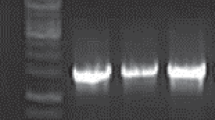Summary
The isomer composition of the lactic acid formed by the various species of lactobacilli was enzymatically determined. It is shown, that the D(-)-lactate formers produce D(-)-lactate exclusively whereas all L(+)-lactate formers always produce a few per cent of the other isomer in addition. The latter is due to the presence of a NAD dependent D-LDH of very low activity. The formation of Dl-lactic acid is either caused by the presence of both stereospecific different LDHs or by the formation of L(+)-lactic acid followed by racemisation. In some species the biochemical basis of the racemate formation is still unknown.
The racemase was isolated and characterised from Lactobacillus curvatus, L. sake and L. casei ssp. pseudoplantarum. This enzyme is induced by L(+)-lactic acid. The induction is inhibited by actinomycine D. A separation of lactic acid racemase and of L-LDH was achieved by the application of a sucrose density gradient.
Zusammenfassung
Eine kritische Überprüfung der von den verschiedenen Arten der Gattung Lactobacillus gebildeten Milchsäure ergab, daß zwar die D(-)-Laktatbildner reines D(-)-Isomer, die L(+)-Laktatbildner aber immer auch einige wenige Prozente des anderen Isomers bilden. Letzteres beruht auf der Anwesenheit einer sehr schwach aktiven NAD-abhängigen D-Laktatdehydrogenase neben der hochaktiven NAD-abhängigen L-Laktatdehydrogenase.
Die Bildung von Dl-Laktat beruht entweder auf der Anwesenheit der beiden stereospezifisch verschiedenen Laktatdehydrogenasen oder auf der Bildung vo L(+)-Milchsäure und anschließender Racemisierung. In einigen Fällen ist die biochemische Grundlage der Racematbildung noch unklar. Bei fast allen Dl-Bildnern ist das Isomerenverhältnis von den Wachstumsbedingungen abhängig.
Bei Lactobacillus curvatus, L. sake und L. casei ssp. pseudoplantarum wurde die für die Dl-Bildung verantwortliche Milchsäureracemase nachgewiesen und näher charakterisiert. Es handelt sich um ein induzierbares Enzym, dessen Induktor L(+)-Milchsäure ist. Die Induktion kann mit Actinomycin D gehemmt werden. Eine Trennung von Racemase und L-Laktatdehydrogenase gelang durch Zentrifugation im Saccharosedichtegradienten, da das Molekulargewicht der Racemase mit 52–60000 in einigen Fällen niedriger liegt als das der Laktatdehydrogenase.
Similar content being viewed by others
Literatur
Abo-Elnaga, I. G., Kandler, O.: Zur Taxonomie der Gattung Lactobacillus Beijerinck. I. Das Subgenus Streptobacterium Orla Jensen. Zbl. Bakt., II. Abt. 119, 1–36 (1965)
Dennis, D.: Lactic acid racemase. In: S. P. Colowick and N. O. Kaplan, Eds.: Methods in enzymology, Vol. V, p. 430. New York: Academic Press 1962
Dennis, D., Kaplan, N. O.: Lactic acid racemisation in Clostridium butylicum. Biochem. Z. 338, 485–495 (1963)
Garvie, E. J.: The production of L(+)-and D(-)-lactic acid in cultures of some lactic acid bacteria, with a special study of Lactobacillus acidophilus NCDO 2. J. Dairy Res. 34, 31–38 (1967)
Gasser, F.: Electrophoretic characterization of lactic dehydrogenases in the genus Lactobacillus. J. gen. Microbiol. 62, 223–239 (1970)
Gasser, F., Gasser, C.: Immunological relationships among lactic dehydrogenases in the genera Lactobacillus and Leuconostoc. J. Bact. 106, 113–125 (1971)
Hiyama, T., Fukui, S., Kithara, K.: Purification and properties of lactate racemase from Lactobacillus sake. J. Biochem. 64, 99–107 (1968)
Hohorst, H. J.: L-Lactatbestimmung In: H. V. Bergmeyer, Ed.: Methoden der enzymatischen Analyse, pp. 266–270. Weinheim: Verlag Chemie 1966
Katagiri, H., Kitahara, K., Fukami, K.: The characteristics of the lactic acid bacteria isolated from moto, yeast mashes for sake manufacture. IV. Classification of the lactic acid bacteria. Bull. Agric. chem. Soc. Japan 10, 156–157 (1934)
Kayser, M. E.: Etudes sur la fermentation lactique. Ann. Inst. Pasteur, 8, 737–784 (1894)
Kitahara, K., Obayashi, A., Fukui, S.: On the lactic acid racemase (racemiase) of lactic acid bacteria, with a special reference to the process of its formation. Proceedings of the International Symposium of Enzyme Chemistry, Tokyo and Kyoto, pp. 460–463 (1957)
Lineweaver, H., Burk, D.: The determination of enzyme dissociation constants. J. Amer. Chem. Soc. 56, 658–666 (1934)
London, J.: Regulation and function of lactate oxidation in Streptococcus faecium. J. Bact. 95, 1380–1387 (1968)
London, J., Meyer, E. Y., Kulczyk, S. R.: Detection of relationships between Streptococcus faecalis and Lactobacillus casei by immunological studies with two forms of malic enzyme. J. Bact. 108, 196–201 (1971)
Man, J. C. de, Rogosa, M., Sharpe, M. E.: A medium for the cultivation of Lactobacilli. J. appl. Bact. 23, 130–135 (1960)
Martin, R. G., Ames, B. N.: A method for determining the sedimentation behaviours of enzymes: Application to protein mixtures. J. biol. Chem. 236, 1372–1379 (1961)
Nencki, M.: Die isomeren Milchsäuren als Erkennungsmittel einzelner Spaltpilzarten. Zbl. Bakt. I. Abt. Ref. IX, 304–306 (1891)
Orla-Jensen, A. D.: Läßt sich die optische Modifikation der gebildeten Milchsäure zur Identifizierung der echten Milchsäurebakterien verwenden? Zbl. Bakt., II. Abt. 104, 251–263 (1941)
Orla-Jensen, J.: The lactic acid bacteria. D. Kgl. Danske Videnskabernes Selskrabs Skrifter, Naturv. Og Mathematiks Afd. 8. Raekke, V. 2, 79–197 (1919)
Pardee, a. B., Prestidge, L. S.: The initial kinetics of enzyme induction. Biochim. biophys. Acta (Amst.) 49, 77–88 (1961)
Rauen, H. M.: Biochemisches Taschenbuch, 2. Teil, 2. Aufl. Berlin-Göttingen-Heidelberg: Springer 1964
Rogosa, N., Wisman, R. F., Mitchell, J. A., Disraely, M. N., assisted by Beamen, A. J.: Species differentiation of oral lactobacilli from man including descriptions of Lactobacillus cellobiosus nov. spec. J. Bact. 65, 681–699 (1953)
Shapiro, S. S., Dennis, D.: Lactic acid racemisation in Clostridium butylicum. Evidence for a direct internal hydride shift. Biochemistry 4, 2283–2288 (1965)
Snoswell, A. M.: Oxidized Nicotinamide-Adenine Dinucleotide-independent lactate dehydrogenases of Lactobacillus arabinosus 17.5. Biochim. biophys. Acta (Amst.) 77, 7–19 (1963)
Stetter, K. O.: Physiologisch-biochemische Untersuchungen zur Bildung von Milchsäureisomerengemischen bei Lactobacillen. Dissertation, Universität München 1973
Author information
Authors and Affiliations
Rights and permissions
About this article
Cite this article
Stetter, K.O., Kandler, O. Untersuchungen zur Entstehung von Dl-Milchsäure bei Lactobacillen und Charakterisierung einer Milchsäureracemase bei einigen Arten der Untergattung Streptobacterium. Archiv. Mikrobiol. 94, 221–247 (1973). https://doi.org/10.1007/BF00417453
Received:
Issue Date:
DOI: https://doi.org/10.1007/BF00417453




